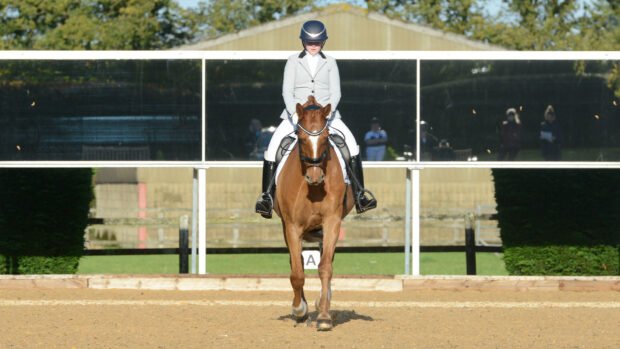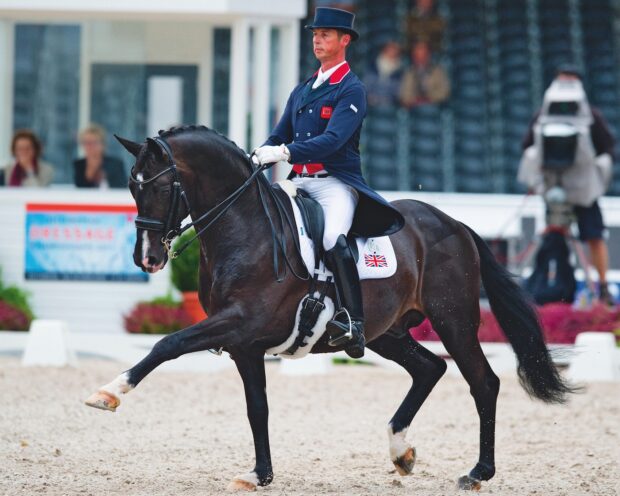If you’re a dressage rider, whether just starting out or aiming for international competition, you’re probably looking at ways in which you can improve your dressage scores. It can often seem as though higher marks are out of reach, especially if your horse is not the biggest mover, or is less established at the level, but in fact it’s possible for any combination to earn extra half-marks here and there throughout their test. And those extra half-marks can have a big impact on your overall dressage score.
We’ve spoken to five-star international dressage judge Isobel Wessels to share some tactics riders can use at any level to ensure they’re getting the highest dressage scores possible.
1. Pay attention to your diagonal lines
“One big thing I see is that riders have no control when they ride a horse on a diagonal line,” Isobel says. “They come off the corner and don’t aim the horse’s shoulders towards the marker, but haphazardly turn onto the diagonal and drift across, ending up a few metres ahead of the marker on a shortened line with the horse not tracking straight. It’s no wonder riders make a mistake at the end of a line of changes because the horse was always drifting one way instead of staying upright.
“If you can learn to ride a really good line right from prelim level, then when you have to do an extended trot or tempi changes, you will find you are automatically on the right line. You’ve maximised your space and the horse is going in exactly the right direction according to the test. The quality of the line you ride makes the movement itself guaranteed to come off better.”
2. Remember corners are your best friend – and don’t underestimate shoulder-in
“Corners set you up for whatever happens next,” says Isobel, explaining that riding a good corner gives you more space and time to prepare for the movement that follows. She uses shoulder-in on the long side as an example of a movement that can be greatly improved simply by riding properly into the corner that precedes it.
“Riding into the corner means you are more likely to come out of it actually riding a shoulder-in. A lot of people cut the corner and then push the quarters out – but quarters out and shoulder-in are not the same thing,” she says, adding that this results in “disengaging the hind legs from the connection of the bridle”.
“Shoulder-in is a difficult movement – I don’t give out many 10s for it – but it is a really good exercise if done properly.”
3. Think like a judge – and then ride accordingly
“Riders need to look at the test and think about when the judge is actually going to be giving the mark – and then make sure you’re doing what you’re supposed to be doing at that moment,” says Isobel, adding that riders should concentrate on maintaining the quality of the movement right to the end, as it is at the end of the movement that the judge will be deciding what mark to give.
For example, she says, it’s no good starting with a perfect leg yield that fizzles out by end, in other words by the time the judge actually gives the mark for that movement.
4. Focus on the easy parts to improve your dressage scores
“Sometimes the answers to getting a few more marks are more simple than people think,” points out Isobel. “If you have a horse that is not the biggest mover, make sure you really nail all those square halts, rein-backs, walk pirouettes – the nitty-gritty things that most people dislike. If you have a well-trained horse you could get lots of 7.5s and eights compared to other horses that make mistakes.”
Isobel advises riders at all levels to study the test and identity areas where they could improve their dressage scores – often with less effort.
“In a lot of tests there is a whole mark just for a transition from canter to trot for example,” says Isobel. “If you can get that right and do it well, you might be able to get an eight or a nine for it. There are lots of places where if you really take care you can elevate your score.”
You may also be interested in…

List One dressage judge Richard Baldwin reveals how riders throw away marks

8 training gems from Carl Hester that could transform your dressage scores

‘Make the most of what you have’: How to improve your dressage scores with any horse

Subscribe to Horse & Hound magazine today – and enjoy unlimited website access all year round
Horse & Hound magazine, out every Thursday, is packed with all the latest news and reports, as well as interviews, specials, nostalgia, vet and training advice. Find how you can enjoy the magazine delivered to your door every week, plus options to upgrade your subscription to access our online service that brings you breaking news and reports as well as other benefits.




